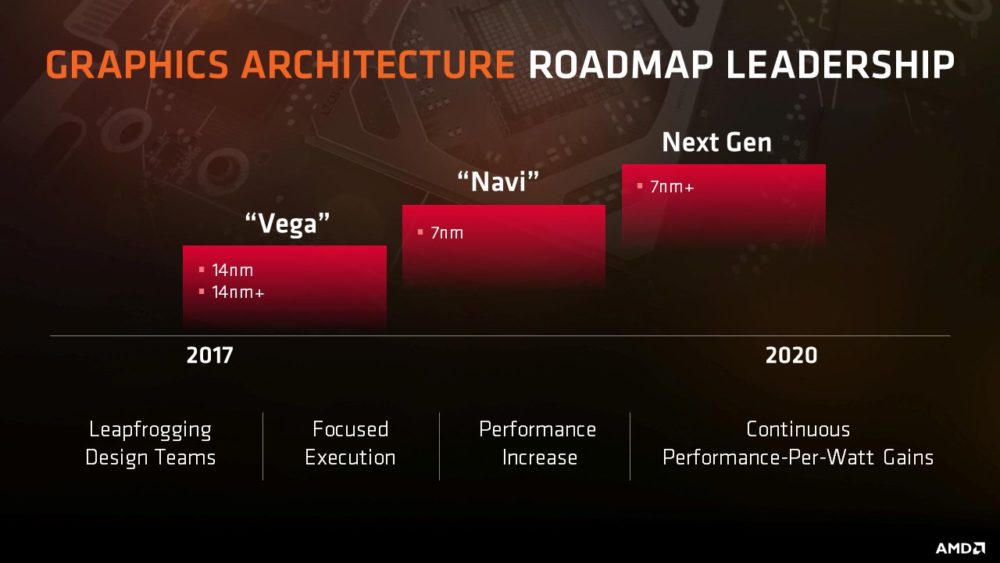With AMD's RX Vega now out and about, it is time to start looking towards the future. We've known for some time that Vega will be followed up by ‘Navi' at some point between 2018 and 2020. Now, we know that progress is being made as AMD's next-gen GPU has appeared in a new driver.
In drivers leading up to Vega, the GPU was codenamed GFX9. The latest Linux driver from AMD contains a reference to the upcoming GFX10 chip: “new_chip.gfx10.mmSUPER_SECRET.enable [0: 0]”. While we already know that Navi is set to be AMD's next gen architecture, GFX10 is labeled as ‘super secret' so the company appears to be keeping things under wraps to avoid raising expectations about a release date. According to Videocardz, Navi may not appear until late 2018, the official roadmap leaves a two year gap, so there is going to be a fairly long wait ahead.
So what do we actually know about Navi so far? We know it will be AMD's first graphics chip based on the 7nm architecture. We also know that it will support ‘next-gen memory', which is likely going to be either HBM3 or GDDR6. We know that GDDR6 is set to start popping up in GPUs in 2018, though HBM3 could be a bit further off.
KitGuru Says: AMD is hard at work on its next generation GPU architecture, though it could be a long time before we see it in action. Nvidia has already kicked off its Volta roll out with the Titan V, so perhaps by the end of next year, we'll get to see the red and green teams face off again. That said, given the leap to 7nm, I wouldn't be surprised if Navi slipped into 2019.
 KitGuru KitGuru.net – Tech News | Hardware News | Hardware Reviews | IOS | Mobile | Gaming | Graphics Cards
KitGuru KitGuru.net – Tech News | Hardware News | Hardware Reviews | IOS | Mobile | Gaming | Graphics Cards




Yea they need to get something out soon mid to late 2018 would be a great time to release something new. But most likely all we will see early 2018 is a refresh of Vega on a smaller node and maybe a very slight increase in clock rates but nothing to write home about.
While AMD is at it they need to figure out what is holding the Vega chips back in performance with the current line up. These chips should be performing much better than they are now as they have the core to do much much more. So either it is the measly 64 ROP’s holding them back or some other bottleneck in the pipeline or just not enough clock speed. Most likely it is a combo of all of this. when the cards do perform up to where they should be in a few games they actually are in line with a 1080 Ti which is where a Vega 64 should be. But for the most part they are performing the same or slightly above a mid tier 1080 card.
These Vega chips have a lot more resources on hand than a 1070,1070Ti,1080 so these Vega’s whether just a 56 or a 64 should be able to walk all over the Nvidia mid tier cards and perform more inline with Nvidia’s 1080Ti & Titan Xp cards in more than a couple of games.
The refresh to 12nm LP should allow AMD to clock Ryzen and Vega much higher at comparable or lower power draw.
Remember than the 14nm LPP that Ryzen and Vega are currently built on is designed for low power and low clocks… the 12nmLP is designed for high clocks and high powered hardware… so Ryzen should be able to normalize for clock discrepancies compared to Intel… or possibly clock a bit higher… and Vega should definitely be able to achieve Pascal level clocks or higher at much lower power draw.
The 1080 is not a mid-tier card! It is a high end card.
Ugh. Look, people, when something is actually super-secret, people don’t label it “super secret” in open-source code. There are no doubt some people out there–probably the ones who entered “new_chip.gfx10.mmSUPER_SECRET.enable [0: 0]” into the driver code–giggling themselves to tears over seeing this published and people taken in by it.
The 1080 is at the top of the mid tier so basically either a low end top card or a top end mid tier card. Currently the 1080Ti carries the flag for flagship card in the consumer sector. I am not saying the 1080 is a slow or bad card as it is the fastest card they have at a pretty great price and is a very good deal and perfect for 1440p gaming and somewhat effective at 4K gaming.
But lets face it the chip is small Pascal which is Nvidia’s high end mid level chip. Back when Nvidia first started doing the small chip & then big chip was with Kepler Geforce GTX 680 & later released the Big Kepler chips with much more performance. They seen so much success with this type of release that they kept on doing it moving forward. They did it first with Kepler because at the time AMD had nothing that performed better than small Kepler.
Regardless of which chip they uses it services the high end of the gaming GPU market. That is what matters most, not the chip size.
They should get something powerful to compete against Pascal at least.
This “Navi support in the Linux drivers” is inaccurate: https://www.phoronix.com/scan.php?page=news_item&px=AMD-Linux-Drivers-Not-Yet-Navi
GTX1080 is only high-end because nVidia set the price high, it’s got a 2nd tier GPU and at least before the Titan series all 2nd tier GPUs were mid-range, i.e GF104/GF114 was GTX460/GTX560, etc.
The whole reason nVidia changed things was because AMD allowed it since AMD’s Tahiti flagship wasn’t any faster than GK104 mid-range chip, hence no reason to put GK100 (which wasn’t working anyway) in GTX680.
In fact, GTX780 was the last x80 card to get the flagship 1st tier processor, albeit cut-down. From then on, flagship stayed with x80 Ti and Titan products. Both GTX980 and GTX1080 had 2nd tier GPU. nVidia doesn’t over-engineer because they can, that’s not how profit-oriented businesses operate.
You mean like Vega 56 being equal to GTX 1080 in games that have been optimised for PC platform, and also in DX12 and Vulkan at 2k and 4k?
Vega 64 behaves similarly and is actually 10% slower than 1080ti under same conditions.
It’s a matter of which way the market swings in terms of optimisations. Most PC gaming devs are in Nvidia’s pockets.
It would be accurate to surmise that AMD needs a better manufacturing process though as currently, Vega is made on a 14nm LPP designed for low clocks and low speeds.
The refresh to 12nm LP (which is designed for higher clocks and higher power), should allow Vega to clock much higher at much lower power consumption.